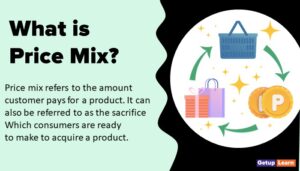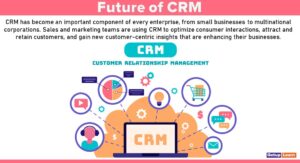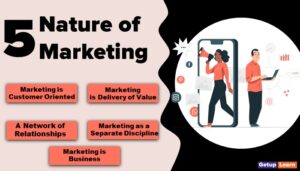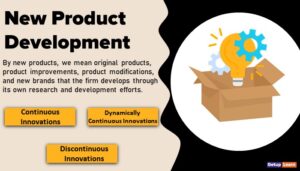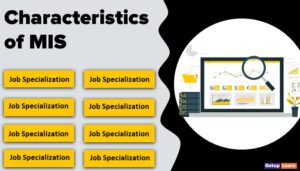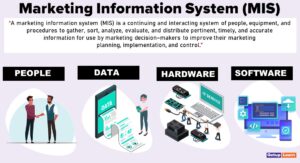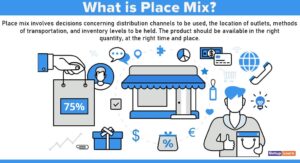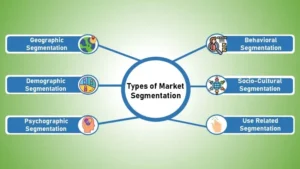Table of Contents
What is Product Mix?
A Product mix refers to an item that satisfies the consumer’s needs or wants. Typical marketing decision regarding product involves deciding what goods or services should be offered to customers. The product provides the primary value to the customer.
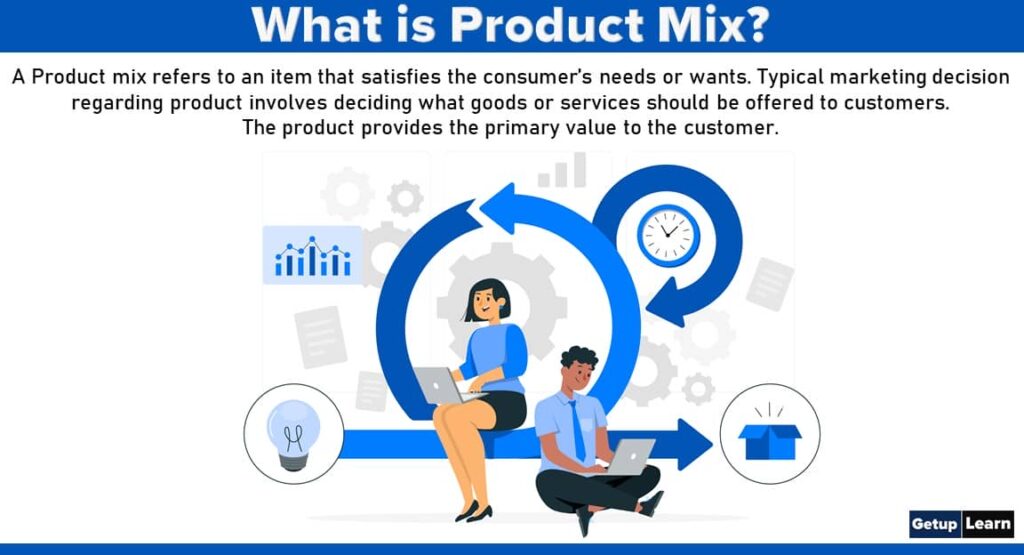
The customer got interested in the company primarily because of the product or service it was producing or proposed to produce. All other elements should be reinforcing the value proposition of the product.
An important element of product strategy is new product development. As technologies and tastes change, Products become out-of-date and inferior to the competition. So the companies must be capable of replacing them with new designs and feature that customer value.
The most challenging task is to include the latest available technologies and solutions to the latest needs of the customer in a company’s product. The decisions regarding products can be related to brand names, warranties, packaging, and services that should accompany product offerings.
Product in Marketing
Product refers to the goods and services offered by the organization. A pair of shoes, a plate of Dahi-vada, lipstick, all our products. All these are purchased because they satisfy one or more of our needs. We are paying not for the tangible product but for the benefit, it will provide.
So, in other words, a product can be described as a bundle of benefits that a marketeer offers to the consumer for a price. While buying a pair of shoes, we are actually buying comfort for our feet, while buying lipstick we are actually paying for beauty because lipstick is likely to make us look good.
The product can also take the form of a service like air travel, telecommunication, etc. Thus, the term product refers to goods and services offered by the organization for sale.
Concept of Product in Marketing
As stated earlier, product refers to the goods and services offered by the organization for sale. Here the marketers have to recognize that consumers are not simply interested in the physical features of a product but a set of tangible and intangible attributes that satisfy their wants.
For example, when a consumer buys a washing machine he is not buying simply a machine but a gadget that helps him in washing clothes. It also needs to be noted that the term product refers to anything that can be offered to a market for attention, acquisition, or use.
Thus, the term product is defined as “anything that can be offered to a market to satisfy a want”. It normally includes physical objects and services. In a broader sense, however, it not only includes physical objects and services but also the supporting services like brand name, packaging accessories, installation, after-sales service, etc. Look at the definitions by Stanton and McCarthy as given in the box.
Definition of Product
These are the two simple definitions of product given below:
[su_quote cite=”William J. Stanton”]Product is a group of tangible and intangible attributes including color, packaging, price, manufacturer’s prestige, retailer’s prestige, and manufacturer’s and retailer’s services which buyers may accept as offering satisfaction of wants and services.[/su_quote]
[su_quote cite=”Jerome McCarthy”]A product is more than just a physical product with its related functional and aesthetic features. It includes accessories, installation, instructions on use, the package, perhaps a brand name, which fulfills some psychological needs, and the assurances that service facilities will be available to meet the customer’s needs after the purchase.[/su_quote]
Product Classification
Products can be broadly classified on the basis of (1) use, (2) durability, and (3) tangibility. Let’s understand the brief about product classification:

Based on Use
The product can be classified on the basis of use:
Consumer Goods
Consumer Goods: Goods meant for personal consumption by households or ultimate consumers are called consumer goods. This includes items like toiletries, groceries, clothes, etc. Based on consumers’ buying behavior the consumer goods can be further classified as:
Convenience Goods
Convenience Goods: Do you remember, the last time when did you buy a packet of butter or a soft drink, or a grocery item? Perhaps you don’t remember, or you will say last week or yesterday.
The reason is, that these goods belong to the category of convenience goods which are bought frequently without much planning or shopping effort and are also consumed quickly. Buying decisions in the case of these goods do not involve much pre-planning. Such goods are usually sold at convenient retail outlets.
Shopping Goods
Shopping Goods: These are goods that are purchased less frequently and are used very slowly like clothes, shoes, and household appliances. In the case of these goods, consumers make the choice of a product considering its suitability, price, style, quality, and products of competitors and substitutes if any.
In other words, consumers usually spend a considerable amount of time and effort to finalize their purchase decision as they lack complete information prior to their shopping trip. It may be noted that shopping for goods involves much more expenses than convenience goods.
Specialty Goods
Specialty Goods: Because of some special characteristics of certain categories of goods people generally put special efforts to buy them. They are ready to buy these goods at the prices at which they are offered and also put in extra time to locate the seller to make the purchase.
The nearest car dealer may be ten kilometers away but the buyer will go there to inspect and purchase it. In fact, prior to making a trip to buy the product he/she will collect complete information about the various brands. Examples of specialty goods are cameras, TV sets, new automobiles, etc.
Industrial Goods
Industrial Goods: Goods meant for consumption or use as inputs in the production of other products or provision of some service are termed as ‘industrial goods’. These are meant for non-personal and commercial use and include:
- Raw Materials
- Machinery
- Components
- Operating Supplies (such as lubricants, stationery, etc).
The buyers of industrial goods are supposed to be knowledgeable, cost-conscious, and rational in their purchase and therefore, the marketeers follow different pricing, distribution, and promotional strategies for their sales. It may be noted that the same product may be classified as consumer goods as well as industrial goods depending upon its end use.
Take for example the case of coconut oil. When it is used as hair oil or cooking oil, it is treated as consumer goods and when used for manufacturing a bath soap it is termed as industrial goods. However, the way these products are marketed to these two groups is very different because purchase by the industrial buyer is usually large in quantity and bought either directly from the manufacturer or the local distributor.
Based on Durability
The product can be classified on the basis of durability:
Durable Goods
Durable Goods: Durable goods are products that are used for a long period i.e., for months or years together.
Examples of such goods are refrigerators, cars, washing machines,s, etc. Such goods generally require more personal selling efforts and have high-profit margins. In the case of these goods, the seller’s reputation and pre-sale and after-sale service are important determinants of purchase decisions.
Non-Durable Goods
Non-durable Goods: Non-durable goods are products that are normally consumed in one go or last for a few uses. Examples of such products are soap, salt, pickles, sauce, etc. These items are consumed quickly and we purchase these goods more often.
Such items are generally made available by the producer through a large number of convenient retail outlets. Profit margins on such items are usually kept low and heavy advertising is done to attract people to their trial and use.
Based on Tangibility
The product can be classified on the basis of tangibility:
Tangible Goods
Tangible Goods: Most goods, whether these are consumer goods or industrial goods and whether these are durable or non-durable, fall in this category as they have a physical form, that can be touched and seen. Thus, all items like groceries, cars, raw materials, machinery, etc. fall in the category of tangible goods.
Intangible Goods
Intangible Goods: Intangible goods refer to services provided to individual consumers or to organizational buyers (industrial, commercial, institutional, government, etc.). Services are essentially intangible activities that provide want or need satisfaction. Medical treatment, postal, banking and insurance services, etc., all fall in this category.
Components of Product Mix
In order to optimize the product requirements of the consumers. These are the following elements or components of product mix:
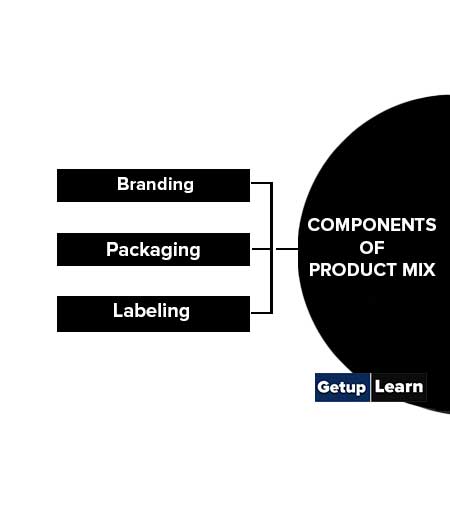
Branding
Branding is the process of using a name, sign, symbol, or design for a product. A brand is an identification of a product. The part of the brand which can be spoken is called the brand name, for example, Detail, Nike, etc. The part of the brand which cannot be spoken about but can be recognized is the brand mark. For example arrow sign of Nike, the star of Mercedez, etc.
A brand that is given legal protection against its use by other firms is called trade mark. e.g., is the trademark of the State Bank of India. Customers demand the product by calling its brand name. For e.g. give one Lux, one Coke, etc. Thus, it helps in product differentiation.
Branding helps companies adopt differential pricing for its product. Customers are ready to accept that price because of its quality. Companies that use their brand name find it easy to market a new product.
Packaging
Packaging is the act of designing and producing an appropriate container or cover for the product.
Level of Packing: There are three levels of packaging given below:
-
Primary Package: It refers to the immediate packing of the product. e.g., a tube of ointment.
-
Secondary Package: It refers to additional packaging which gives protection to the product. e.g., a Cardboard box used to keep an ointment tube. Such containers and boxes are dispensed units where we start using the inside material from the primary package.
- Transportation Packaging or Final Packaging: It refers to further packaging components necessary for storage or transportation. e.g., boxes of ointments are transported in corrugated boxes each containing 50/100 items
Packaging protects the product from damage. It helps to identify a product. It enables convenient handling of the product. As a package increases the sale of a product, it acts as a silent salesman.
Labeling
A label is a part on the cover of the product which will devote its name, contents, ownership, expiry date, manufacturing date, etc. A label helps in identifying the product. It is full of information about the product. It helps in grading the product. It attracts customers because of its colorful packaging.
What is Product in Marketing?
A product can be described as a bundle of benefits that a marketeer offers to the consumer for a price. While buying a pair of shoes, we are actually buying comfort for our feet, while buying lipstick we are actually paying for beauty because lipstick is likely to make us look good.
What is the Concept of Product in Marketing?
Product is a group of tangible and intangible attributes including color, packaging, price, manufacturer’s prestige, retailer’s prestige, and manufacturer’s and retailer’s services which buyers may accept as offering the satisfaction of wants and services.
What is the product classification in marketing?
These are the product classification given below:
1. Consumer Goods
2. Industrial Goods
3. Durable Goods
4. Non-Durable Goods
5. Tangible Goods
6. Intangible Goods.
What are the three components of product mix?
Following are the three elements or components of product mix:
1. Branding
2. Packaging
3. Labeling.

